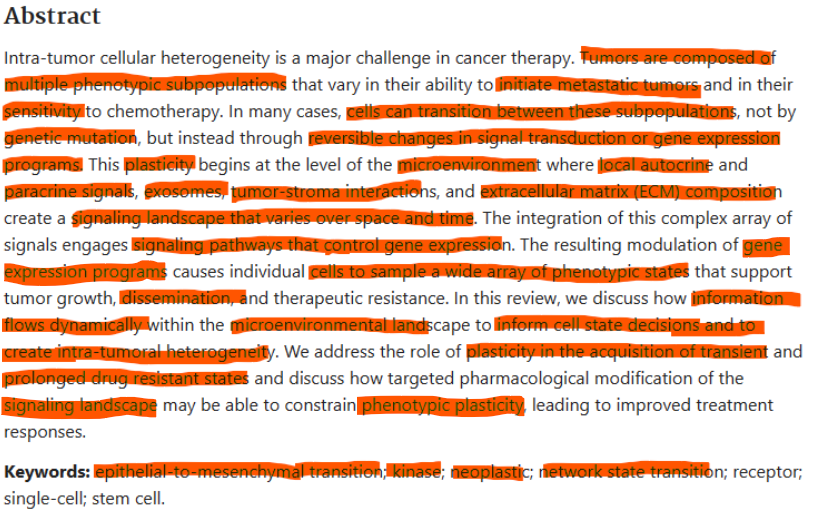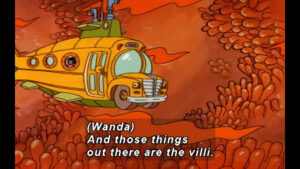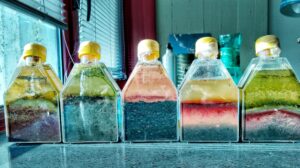
Have you ever seen a starship launch? If yes, you surely must have felt a sense of awe or wonder at the notion that people can build ships capable of exploring the stars. I am training to be a biological engineer, but ever since I was young, I have always wanted to be a physicist.
I remember visiting my local planetarium and seeing videos of matter colliding, zooming out to the scale of the universe. This made me feel incredibly insignificant, yet part of a complex whole beyond the limits of my own understanding. As a child, I was also exposed to great media about physics through documentaries about Einstein and radio shows.
Physics has long been romanticized. Generations of students have dreamt of journeys to the stars. And this romanticization—spurred forth through engaging education, TV shows, and books—has led to a broad appreciation of the field. Biology can be just as wondrous and scintillating, yet I’d argue that most people don’t appreciate it quite as much. Every person I know who works in biology has an obsessive reason for doing so; they often comment on the intricate beauty, or inexplicable complexity, of living cells. In recent decades, scientists have invented technologies to control cells by using different frequencies of visible light, and have engineered cells to produce diverse molecules such as artemisinin, an antimalarial drug, or synthetic insulin for diabetics. So why is biology not romanticized to the same extent as physics?
If this is truly the dawn of a biological revolution, then we should strive to romanticize biology in every way possible and bring the next generation of builders into the field. This will be no small feat. Biology is complex and difficult to observe. But it doesn’t need to be. We need to make biology education accessible and engaging, while continuing to create and spread beautiful visuals of biology.
When I took my first biology class in highschool, I was lucky to have an amazing teacher. I recall watching her do a mouse dissection, and letting me take the organs apart myself afterwards. It was crazy to think that much of the machinery within a mouse existed inside of me as well. Constantly coordinating, modulating, moving, so that I could simply be. In that moment, biology felt much more tangible than the physics I once dreamt of doing. I wanted to understand the little molecular machines (e.g. proteins) that make us who we are. From there I thought biology was all rainbows and sunshine; we can see biology all around us, so it can’t be that difficult to figure out. As a high school student, I landed a position in a biostatistics professor’s laboratory. But any promise of rainbows and sunshine was quickly flipped on its head.
I remember the first thing I was asked to do was to scour the literature for “DEGs of interest” in breast cancer, even though I had zero idea what that meant. I figured out eventually that these were differentially expressed genes – another series of characters that had no meaning to me. Then, I tried to read a research paper, and it must have taken me a week just to get through the abstract. I barely understood a single sentence. Many late nights were spent staring, hunched in my chair, reading, and rereading; the loud whir of my computer reminding me that I had far too many tabs open.

I was stuck. I barely understood anything, and had no idea how I could make an impact with the little knowledge I had.1
Biology has become increasingly overwhelming for someone looking to get in. It often feels as if you have to study a specific question for your whole life to make a meaningful impact.2 But even though things have gotten complicated, we should still make room for romance. We are entering an entirely new era of biology. Throughout history, we have often been explorers in biology, rather than inventors. Now, we are at the cusp of biological innovation where we are starting to build with biology rather than just exploring the maps that exist.
So, why do we still teach biology in a way akin to geography? We are often taught to memorize things, rather than learn principles that we are later challenged to apply. When I ask my non-biology friends what they think about biology, they mostly say the same thing: “….what you’re working on sounds so cool. I did not want to have to spend so much time just memorizing ….”. They all wanted to learn some applicable skills and tools. As James Somers mentions in his essay, “I should have loved biology,” enormous subjects are often approached best in thin, deep, slices. Imagine a pie of knowledge with a delightfully rich filling. Would you rather get a slice of pie, or just crust from all around the pie?3 I think the thin deep slice of pie would leave you craving more knowledge, and much more stimulated, than if you just got a bit of crust from all around the pie. Right now we are mostly failing to give biology students these satisfying slices.

Concepts are taught blandly, with emphasis on retaining rather than understanding and applying. Biology still has so much left to discover, but we should start treating it like a toolbox. We may not know every nut, bolt, and screw with which biology is built, but we live by its wonder every single day, from the plants in our home to the foods we eat and the detergents we use to wash our clothes.4 Biology is the unacclaimed driver of our lives. And if we start treating it as a toolbox that can be used to build an exciting future—including longer lives, bolstered food security, and decarbonization—then maybe then we might begin to address some of the confusion and mistrust surrounding scientific advancements.
Seemingly rapid advancements like RNA vaccines are scary when the public hears about them all of a sudden. But if we take biological innovations and translate them into understandable examples, then it makes it so much easier to idealize what biology can achieve. This abstraction of difficult concepts is essential in making biology more approachable and accessible.
Abstraction of biology is not a new concept either. When I talk about my research to my non-biology friends, I cannot hope for them to understand what I mean by saying “biosynthetic pathway elucidation” or “a programmable and modular oncogene targeting and pyroptosis inducing system”. A 16-year-old me would have stared blankly, followed by hundreds of new tabs opened on my computer that evening. Abstraction should become core to the way we speak biology, in particular outside of the confines of academia. How can you wonder at the marvel of biology if all you hear is “envelope capsid design”? We need to carefully survey how we present our ideas to the public, such that they can marvel and wonder at the beauty of what we have built.5
Beyond treating biology as a literary art, we also need to treat it like a visual art. One of the best ways we can make biology abstract and understandable is through visual media. We have the tools to generate structures of the proteins that run our cells, so we could get students to visualize different structures, and consider why certain versions work better than others. Students should be allowed to observe cells under the microscope, and even do simple labs that change the color of bacteria, so they can visually see the products of their “engineering”. Beyond just creating more visual opportunities for students to be exposed to, we need more visual media.
The closest thing I can think of being an excellent romanticization of biology is the Magic School Bus. This series, created 30 years ago, was an excellent way to stimulate the imagination of younger generations on what biology actually is. This was created at a point when we were still much more explorers than engineers, and if we brought back the series today, there’d be even more wild science to explore. But beyond fictional children’s shows, we need real-world displays as well.

We have beautiful planetariums, and museums of air and space, yet where are our bio-teriums? Where is the Museum of Applied Biology and all of its interactive exhibits? Exhibits should not just be hardware, or objects. They should allow us to interact with matter at the smallest level possible, and actually see that we are capable of building with biology. We need interactive exhibits—like the one I first saw in the planetarium when I was young—that make us marvel at the complexity and beauty that biology has to offer.
Most of the biological exhibits I grew up exposed to were quite bland. At best I got to see some videos of how plants take light and make energy; nothing about designing cool biological systems, or wondering about tools that could be applied to biology. If we truly want to bring the next generation of builders into the fold, it is paramount that we make it easy to wonder about biology.
Winogradsky columns are a simplistic, beautiful example of a biological exhibit. Simple to make (all it takes are some eggs, toilet paper and pond water), this presents like a dynamic piece of art. Beautiful enough to snag someone’s initial attention, informative enough to enable someone to wonder what else could be done with biology. What if we take these exhibits a step further, and integrate a safe bacteria that shines at night – kids won’t be trading lava lamps at show and tell anymore, but bioluminescent puddles of bacteria. Another wonderful exhibit are the silk pavilions generated by Neri Oxman. These structures demonstrate what other biological organisms can achieve, displayed in a beautiful structure for us to appreciate. But why stop there? There are so many other ideas that could be broadly implemented to make biology more intriguing and wonderful.6 If we hope to make future innovators wonder about biology, we need to catch their attention with simple on the surface, but intricate underneath the abstraction, displays of biological beauty.

Biology, at its core, explains the vast sophistication of life as we know it. 3.7 billion years ago life on Earth existed only in the form of unicellular microbes. Now, our world is erupting with an unimaginable complexity and diversity of organisms. As humans we are made of around 30 trillion cells that govern an ineffable amount of moving parts. Our existence is a marvel and deserves to be treated as such. We now have a chance to create and play with biological complexity all around us. However, to do so, we must first convince the public to dream with biology. Humanity cannot embrace a biological revolution without making biology understandable, and intriguing.
Appendix
- Learning biology can be overwhelming at first, and I never felt like I had the capacity to make an impact with such little knowledge. Some great resources and places to look for more knowledge on the subject: Molecular Biology of the Cell, The Codon Guide to Synthetic Biology, James Somers’ I should have loved biology, and A Journey to the Center of Our Cells.
- The same can be said for many disciplines. Physics is not a simple field that anyone can immediately grasp; the amount of collective knowledge we have is immense. This does not stop other disciplines from capturing the public’s imagination.
- Is it better to teach very few but extremely specific guiding principles, or broadly show many potentially interesting examples to give students the opportunity to find what they like? I am by no means an expert in teaching, and I definitely value both methods, since if it weren’t for thin deep slices, I would have never found my love for biology. If it weren’t for broad approaches I would have found physics too complicated, and never been enamored by it. When we approach dense topics, foundational bases are helpful, but cool specific applications are the ones I would go home and tell my parents about.
- Understanding every nut, bolt and screw is a difficult task. Biology is inherently complex because compared to other engineering disciplines, we have not built it from the ground up. Every nut is not machined to perfection, there is not a set of standard parts. Many efforts, and amazing thinkers have made a lot of progress to help us get there, but we still have a long way to go.
- We need simple analogies for the work we are doing in biology. Analogies have limitations, but are also simple ways to abstract basic concepts. Some widely used examples are: “Engineering Biology is like coding, we are essentially taking code – DNA – and trying to make the operating system – the cell – do something useful,” or “Genetic circuits are analogous to electrical circuits in their intended goals; the output is unfortunately much less clear cut.” If we really want to strive for excellence in our words, we can’t just say non-attainable beautiful English sentences. For example, if I say: “I want to engineer fire retardant mycelium walls”. That sounds incredible – you just plant some mushrooms and it fireproofs your home. However, when we think about the current set of tools now, this is not engineerable – we don’t have the tools to direct mushrooms to produce fire-retardant, let alone grow in a precisely machined way. We need to speak English sentences that are captivating, but also achievable.
- Other biologically inspired ideas for displays:
- Fluorescent petunias from light bio – Glowing plants by Light Bio
- What if kids could take swabs of their mouth, and quickly see the oral flora that resides there? – Biogeography of a human oral microbiome at the micron scale | PNAS – Figure 3 has some beautiful images.
- Biological Image Competitions could be displayed in Museums – Image Competition | British Society for Cell Biology (bscb.org)
- Macrophages capturing E. coli Macrophage in action vs E. coli: MOA Animation of Phagocytosis, a fundamental immunological process (youtube.com)
- Instructions if you want to make some Winogradsky columns – Bacteriopolis | Exploratorium Museum Exhibit
- Liquid Trees! – ‘Liquid trees’ trends on the internet, reintroduces algae alternative concept for cities (wpde.com)
